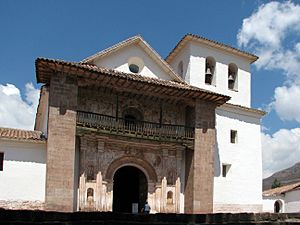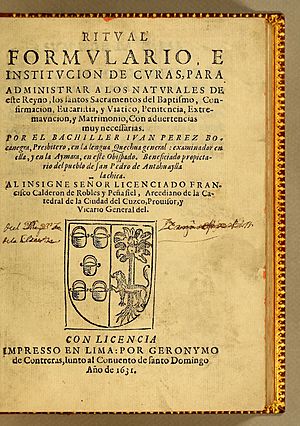Juan Pérez Bocanegra facts for kids
Juan Pérez de Bocanegra was a Catholic priest who lived a long time ago, dying in 1645. He was part of a group called the Third Order of St. Francis. He was also a talented musician and an expert in the local languages of Peru during the time it was a Spanish colony.
Life and Work
Juan Pérez de Bocanegra became a well-known expert in the native languages and customs of the Viceroyalty of Peru. This was the name for the Spanish colony in South America.
He first taught Latin at the University of San Marcos in Lima. Later, he moved to Cusco. In Cusco, he worked as a cantor (a church singer and choir leader) at the Cathedral of Santo Domingo. He held this job from about 1599 to 1611. He also checked and corrected choir books.
Pérez de Bocanegra was very important for understanding local languages. He was the main examiner for the native languages Quechua and Aymara. He worked for the Diocese of Cusco. For many years, he was also a parish priest in a town called Andahuaylillas.
His name is even found on the main stone of the church in Andahuaylillas. He hired a painter named Luis de Riaño to create beautiful murals inside the church. Because of these amazing paintings, the church is sometimes called "the Sistine Chapel of America."
Language and Translation
As a Franciscan, Pérez de Bocanegra sometimes had different ideas from the Jesuits. They disagreed on how to translate Christian words into native languages. The Jesuits preferred to use Spanish words directly, called loan words. They thought this would avoid any misunderstandings.
However, Pérez de Bocanegra liked to use the rich images and ideas already found in Andean languages. He wanted to make the translations feel more natural to the local people. Even though the Jesuit way became official, he continued his own method. He avoided word-for-word translations and kept the Spanish and Quechua parts separate in his writings.
He and the Jesuits also had different plans for Andahuaylillas. The Jesuits wanted to turn his parish into a training center for the Quechua language. They had already set up a similar center for Aymara in Juli.
Important Writings
Pérez de Bocanegra is most famous for a book he published in 1631. It was called Ritual, formulario e institución de curas. This book provided texts for various church rituals in both Quechua and Spanish.
The book is especially known for including Hanacpachap cussicuinin. This is the earliest polyphonic (meaning it has multiple voice parts) vocal song printed in the New World. It is not known if Pérez de Bocanegra wrote the hymn himself or if a local person composed it.
Writings
- Juan Pérez Bocanegra. Ritual, formulario, e institución de curas para administrar a los naturales de este reyno, los santos sacramentos del baptismo, confirmacion, eucaristia, y viatico, penitencia, extremauncion, y matrimonio: con aduertencias muy necessarias. Lima: Geronymo de Contreras, 1631. This book is a guide for priests to perform sacraments for native people. You can find a digital copy of it.
See also
 In Spanish: Juan Pérez Bocanegra para niños
In Spanish: Juan Pérez Bocanegra para niños



